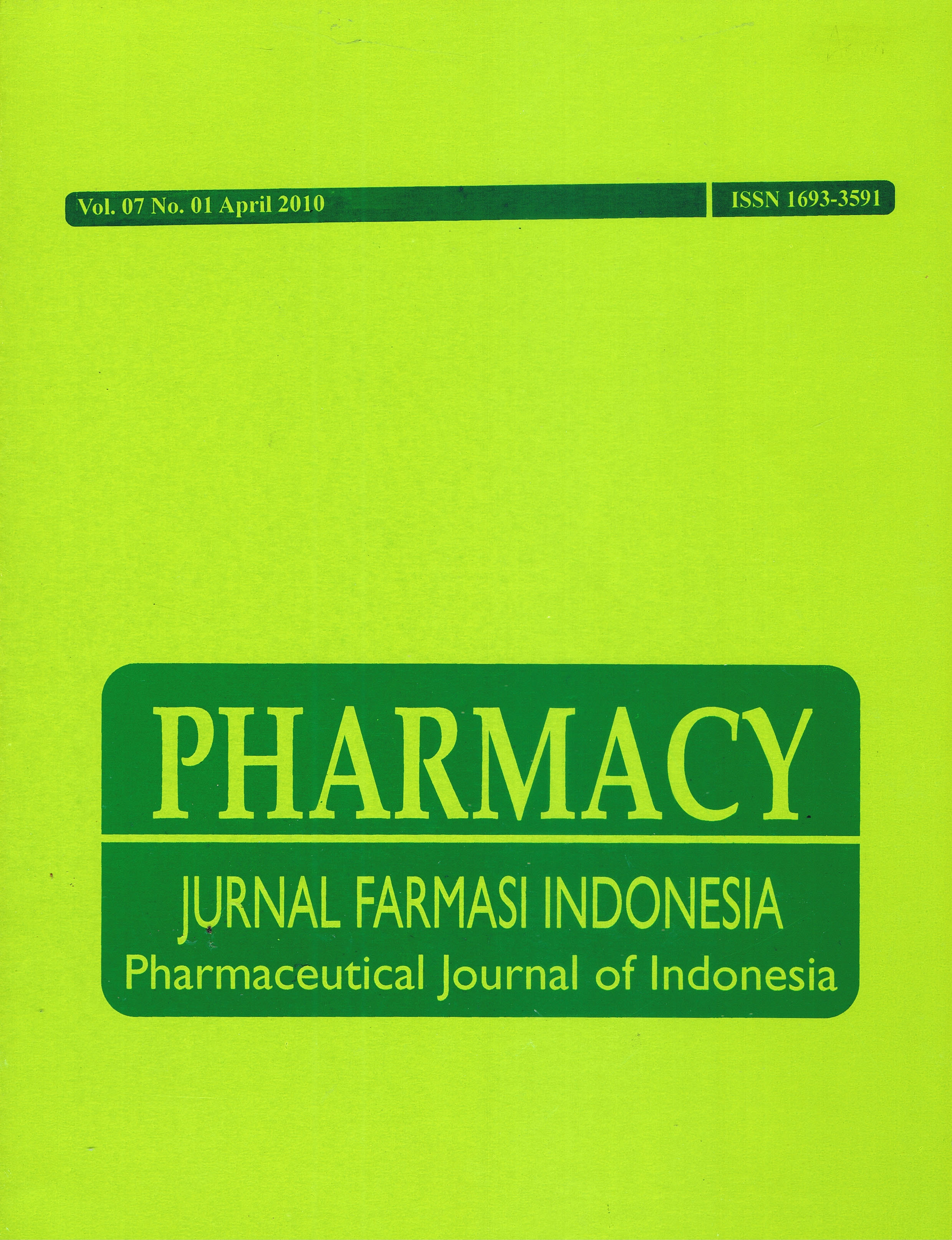PENGARUH PENAMBAHAN AVICEL PH 101 TERHADAP SIFAT FISIS TABLET EKSTRAK BAWANG PUTIH (Allium sativum. L) SECARA GRANULASI BASAH
DOI:
https://doi.org/10.30595/pji.v7i1.547Abstract
ABSTRAK Umbi bawang putih dapat digunakan untuk menurunkan tekanan darah. Telah dilakukan penelitian tentang tablet ekstrak bawang putih dengan variasi Avicel PH 101 sebagai bahan penghancur dan sifat fisis tablet ekstrak bawang putih. Ekstrak bawang putih dibuat dengan metode maserasi dengan penyari etanol 96%. Tablet ekstrak bawang putih dibuat dengan metode granulasi basah dengan bobot tiap tablet 600 mg. Tablet ekstrak bawang putih dibuat dalam tiga formula dengan variasi Avicel PH 101 sebagai bahan penghancur yaitu Formula I (7,5%), Formula II (10%), dan Formula III (12,5%). Granul yang dihasilkan diuji sifat alirnya sedangkan tablet diuji sifat fisisnya meliputi keseragaman bobot, kekerasan, kerapuhan, dan waktu hancur. Hasil penelitian menunjukan Avicel PH 101 dapat digunakan sebagai bahan penghancur tablet ekstrak bawang putih dengan konsentrasi 7,5 – 12,5%. Semakin tinggi konsentrasi Avicel PH 101 maka kecepatan alir granul dan kekerasan tablet semakin turun, kerapuhan semakin naik dan waktu hancur menjadi lebih cepat. Kata kunci : bawang putih, Avicel PH 101, tablet, granulasi basah ABSTRACT Garlic tuber is proved decreasing blood pressure. The research on formulation of garlic extract tablet using Avicel PH 101 as disintegrant and the tablets physical characteristic has been conducted. Garlic extract is prepared by maceration with ethanol 96% as solvent. Tablet of garlic extract is made by wet granulation method with weight of tablet 600 mg each. Tablet of garlic extract is made in three formulas with varied Avicel PH 101 as disintegrant, they are Formula 1 (7.5%), Formula II (10%), and Formula III (12.5%). The obtained granule is tested the flow rate whereas tablets are examined the physical characteristic (weight uniformity, hardness, brittleness, and disintegration time). The results shows that Avicel PH 101 can be used as disintegrant of garlic extract tablet with concentration 7.5 – 12.5%. The higher Avicel PH 101 concentration will decrease granule flow rate and tablet hardness, increase brittleness and fasten disintegration time. Key words: garlic, Avicel PH 101, tablet, wet granulation.References
Depkes RI. 1979. Farmakope Indonesia Edisi III. Jakarta: Departemen Kesehatan Republik Indonesia.
Depkes RI. 1985. Cara Pembuatan Simplisia.Jakarta: Depatemen Kesehatan Republik Indonesia.
Depkes RI. 1986. Sediaan Galenika. Jakarta: Depatemen Kesehatan Republik Indonesia. Hlm 10, 11
Depkes RI. 1995. Farmakope Indonesia Edisi IV. Jakarta: Depatemen Kesehatan Republik Indonesia. Hlm 5, 404, 515, 771
Goeswin.2007. Pengembangan Sediaan Farmasi. Bandung : IPB. Hlm 86
Lachman,.1994.Teori dan Praktek Farmasi Industri Edisi III Jilid II.Terjemahan; Jakarta:UI Press. Hlm 651, 658,679,684,685,697,701,702,703
Parrot.E.L,1971.Pharmaceutical Teknologi Fundamental Pharmaceutics.Burgess.
Publishing company: mimeapolis. Hlm 76,82
Sulaiman,T.N.S., 2007. Teknologi dan Formulasi Sediaan Tablet. Yogyakarta: UGM Press.
Voigt,R. 1995. Buku Pelajaran Teknologi Farmasi Edisi V. Terjemahan Yogyakarta: UGMPress.
Wahyuistiana.2006. Pengaruh Penggunaan Avicel PH 102 Sebagai Filler-Binder terhadap Pembuatan Tablet Ekstrak Bawang Putih (Allium sativum. L) Secara Granulasi Kering, Http://Top/S1-Final Projects/Fakultas Farmasi/K100-2006/jptums-gdl-s1-2006-wahyuistiana-2260
Downloads
Published
How to Cite
Issue
Section
License
Authors who publish with this journal agree to the following terms:
- Authors retain copyright and grant the journal right of first publication with the work simultaneously licensed under a Creative Commons Attribution 4.0 International License that allows others to share the work with an acknowledgement of the work's authorship and initial publication in this journal.
- Authors are able to enter into separate, additional contractual arrangements for the non-exclusive distribution of the journal's published version of the work (e.g., post it to an institutional repository or publish it in a book), with an acknowledgement of its initial publication in this journal.
- Authors are permitted and encouraged to post their work online (e.g., in institutional repositories or on their website) prior to and during the submission process, as it can lead to productive exchanges, as well as earlier and greater citation of published work (See The Effect of Open Access).






